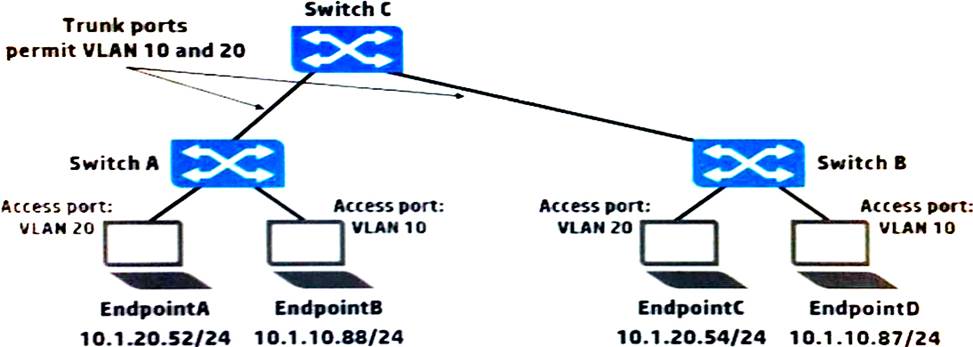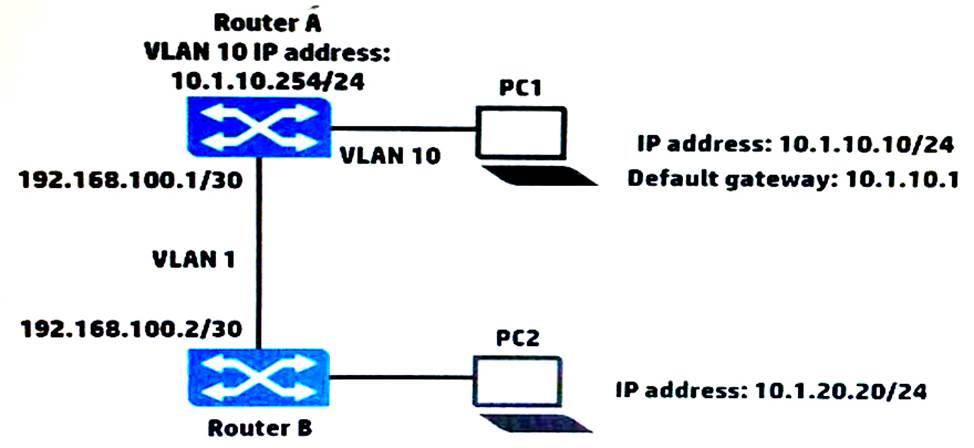HP HP0-Y52 Applying HP FlexNetwork Fundamentals Online Training
HP HP0-Y52 Online Training
The questions for HP0-Y52 were last updated at Dec 23,2025.
- Exam Code: HP0-Y52
- Exam Name: Applying HP FlexNetwork Fundamentals
- Certification Provider: HP
- Latest update: Dec 23,2025
Refer to the exhibit.

The topology shown in this exhibit implements Multiple Spanning Tree Protocol (MSTP), where all the switches are in the same region.
How many MSTP instances, besides the Internal Spanning Tree (IST) or instance 0, does this network need in order to have effective load sharing on the uplinks from the access switches?
- A . two
- B . three
- C . four
- D . five
Which command can a network administrator execute on an HP Comware switch to manage configuration files?
- A . delete
- B . startup-default
- C . write file
- D . write memory
Refer to the exhibit.

Which endpoint or endpoints receive broadcast ARP requests sent by EndpointA?
- A . EndpointB, EndpointC, and EndpointD
- B . EndpointB only
- C . EendpointB and EndpointC only
- D . EndpointC only
Refer to the exhibits.
Exhibit 1

Exhibit 2

PC1 cannot reach PC2. Based on the exhibits, what could be causing this error?
- A . PC1 has the wrong IP address for its default gateway setting.
- B . Router A has a direct route, instead of a static route, to 10.1.10.0/24.
- C . The next hop address for the 10.1.20.0/24 route is incorrect.
- D . Router A has an invalid subnet mask for the VLAN 1 subnet.
What does the traceroute command identify on an HP ProVision switch?
- A . each Layer 3 device between the switch and a destination
- B . the path to each router connected to the switch
- C . debug output tracing entries to the routing table
- D . each physical device between the switch and a destination
An HP ProVision switch is operating at its factory default settings. A network administrator connects the switch to a VLAN with a DHCP server. The switch-to-switch connection is carrying untagged traffic. The administrator wants to log in to the switch CLI using Telnet.
How should the administrator contact the switch and log in?
- A . Contact the switch at its DHCP-assigned IP address and log in with the default password hp.
- B . Contact the switch at its default IP address 192.168.1.1/24 and log in without entering a password.
- C . Contact the switch at its DHCP-assigned IP address and log in without entering a password.
- D . Contact the switch at its default IP address 192.168.1.1/24 and log in with the default password hp.
Which statement correctly defines the management capabilities of an HP MultiService Mobility (MSM) access point (AP)?
- A . The AP only supports controlled mode.
- B . The AP operates in autonomous mode by default, but can be changed to controlled mode.
- C . The AP operates in controlled mode by default, but can be changed to autonomous mode.
- D . The AP only supports autonomous mode.
Two switches are members in an active Intelligent Resilient Framework (IRF) virtual device. A network administrator joins a third switch to the IRF virtual device.
Which switch is now the master?
- A . The current master of the IRF virtual device always remains the master.
- B . The switch with the lowest member ID always becomes the master.
- C . The switch with the lowest priority value always becomes the master.
- D . The switch with the highest priority value always becomes the master.
Refer to the exhibit.

The network administrator is setting up Multiple Spanning Tree Protocol (MSTP) with the settings shown in the exhibit. All the switches are in the same region. The administrator has requested help determining which VLANs each switch-to-switch link should carry.
What is a recommendation for this topology?
- A . To prevent disruptions during link failure, Links 1-4 should carry VLANs 10-13.
- B . To optimize forwarding, Links 1 and 2 should only carry VLANs 10 and 12, and Links 3 and 4 should only carry VLANs 11 and 13.
- C . To ensure compatibility with MSTP, Links 1-4 should be untagged in VLAN 1 and have no tagged VLAN assignments.
- D . To optimize forwarding, Links 1 and 3 should only carry VLANs 10 and 11, and Links 2 and 4 should only carry VLANs 12 and 13.
Refer to the exhibit.

A network administrator has implemented link aggregation on an HP Comware switch using LACP. The two ports are functioning at the data link layer between the Comware switch and its neighboring switch. The administrator executes the display link-aggregation verbose command and notices the flags shown in the exhibit.
What does this indicate?
- A . The links are up, but both links are blocked by LACP.
- B . The links are up, but are blocked because they are using duplicate operational keys.
- C . The links are up, but LACP negotiation has failed on them.
- D . The links are up, but LACP is not configured on this link aggregation.
Latest HP0-Y52 Dumps Valid Version with 116 Q&As
Latest And Valid Q&A | Instant Download | Once Fail, Full Refund

